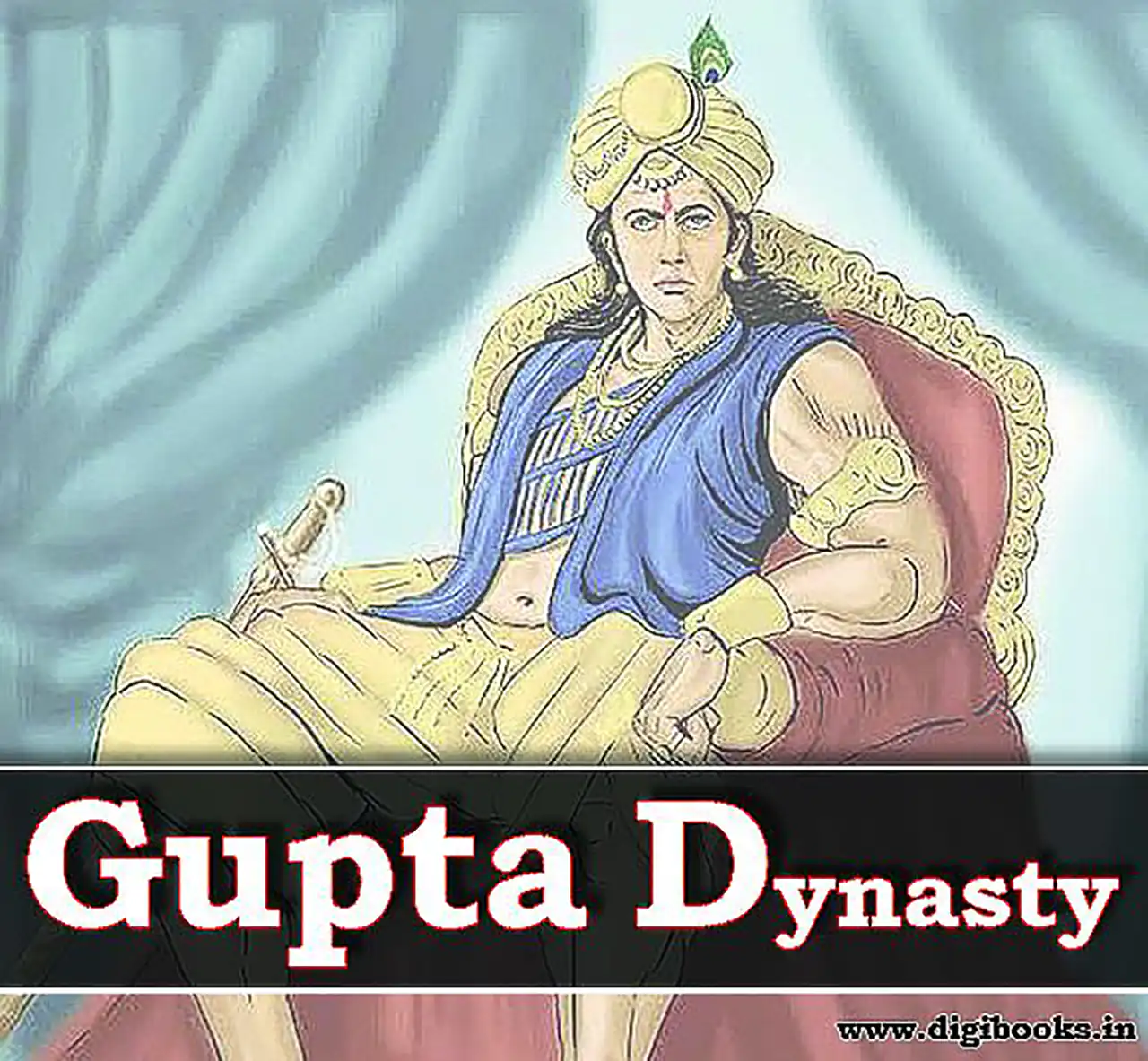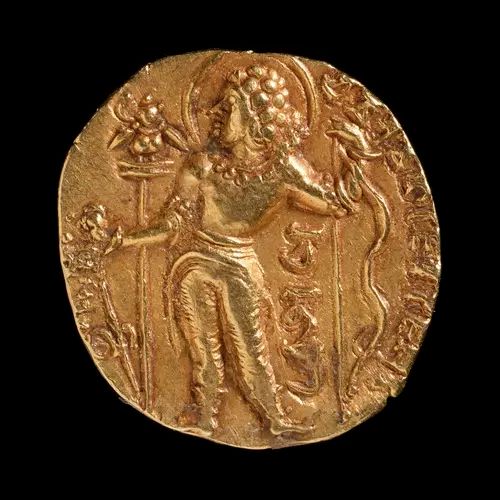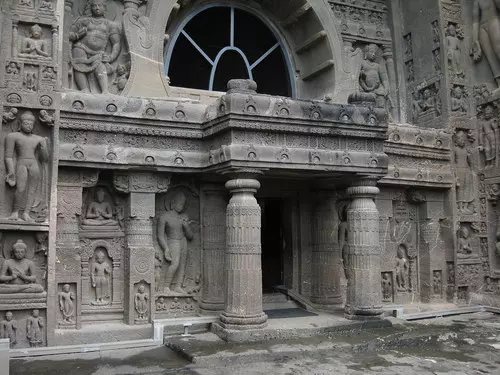Gupta Dynasty / Empire

Gupta Dynasty / Empire
The Gupta Empire dominated a large portion of northern, central, and southern India from roughly 320 to 550 CE. Philosophical, religious, scientific, architectural, and artistic accomplishments of the period are honoured. Chandragupta I (320–335 CE), the Gupta Realm's first sovereign monarch, saw the Gupta Realm expand rapidly throughout his reign. It marked the end of the 500 years of turmoil and provincial power supremacy that had followed the fall of the Mauryas. More significantly, it marked the start of a time of general prosperity and expansion that lasted for the following 2.5 centuries and was referred to in Indian history as a "Golden Age." However, the dynasty's golden age began around 240 CE when Srigupta, who was then simply a provincial ruler, ignited the seeds of the empire at least two generations earlier.
Gupta Period – Early Days to the Zenith
The early history of the Gupta dynasty is not well documented. The most reliable sources of knowledge we have about those times are the travel journals and writings of Buddhist monks who frequently visited this region of the world. The journey accounts of Fa Hien (Faxian, c. 337–422 CE), Hiuen Tsang (Xuanzang, 602–664 CE), and Yijing (I Tsing, c. 635–713 CE) are extremely helpful in this regard. Only Magadha and likely a portion of Bengal made up the Gupta Empire under Srigupta's tenure (about 240–280 CE). Srigupta governed from Pataliputra, a location not far from present-day Patna, like the Mauryas and other Magadha rulers who came before him. Ghatotkacha, Srigupta's son (r. 280–319 CE), succeeded his father to the throne.
Chandragupta I
The Gupta monarchs learned the value of having a cavalry from the Kushans, and Chandragupta I, son of Ghatotkacha, effectively utilised his large army. Chandragupta I acquired ownership of rich mines full of iron ore next to his realm by his marriage with Licchhavi Princess Kumaradevi. As metallurgy had already advanced, forged iron was not only employed to satisfy domestic demand but also rose to prominence as a valuable trade good. The territorial lords in charge of different regions of India were unable to defeat Chandragupta I's greater military might and were forced to submit to him. It is assumed that the Gupta Empire's borders have reached Allahabad by the conclusion of his rule.
Samudragupta
The next monarch, Chandragupta I's son Samudragupta (c. 335–375 CE), was a military prodigy who continued the expansion of the empire. Samudragupta turned his attention to South India after capturing the remaining territory in North India, and by the end of his Southern Campaign, he had added some of it to his kingdom. The Gupta Empire is usually accepted to have extended during his reign from Balkh, Afghanistan in the west to the Brahmaputra River in the east, and from the Himalayas in the north to the mouth of the Krishna and Godavari rivers in the south.
Samudragupta paid particular attention to the rajdharma (royal responsibilities) and took special care to adhere to Kautilya's (350–275 BCE) Arthashastra, a book on economics, society, and politics that contains detailed guidelines for how a monarchy should be run. He made significant financial contributions for a range of charitable causes, including the advancement of education. He was a poet and musician in addition to being a brave king and competent administrator. His extensive use of gold coins demonstrates his diverse talent. The Allahabad Pillar, an inscription that was likely commissioned by later Gupta monarchs, speaks most movingly about his compassionate traits. Samudragupta was a proponent of fostering harmony between various religious groups. For instance, he granted Meghavarna, the monarch of Ceylon, approval and assistance for the construction.
Samudragupta paid particular attention to the rajdharma (royal responsibilities) and took special care to adhere to Kautilya's (350–275 BCE) Arthashastra, a book on economics, society, and politics that contains detailed guidelines for how a monarchy should be run. He made significant financial contributions for a range of charitable causes, including the advancement of education. He was a poet and musician in addition to being a brave king and competent administrator. His extensive use of gold coins demonstrates his diverse talent. The Allahabad Pillar, an inscription that was likely commissioned by later Gupta monarchs, speaks most movingly about his compassionate traits. Samudragupta was a proponent of fostering harmony between various religious groups. For instance, he granted Meghavarna, the monarch of Ceylon, approval and assistance for the construction.
.png.jpeg)
After Samudragupta's rule, there seems to have been a brief power struggle. The following Gupta ruler was his eldest son, Ramagupta. In his autobiographical work, Harshacharita, Sanskrit author Banbhatta from the seventh century CE made note of this. What happened next is a portion of the drama Devi Chandra Guptam by Sanskrit playwright and poet Visakh Dutta. According to the legend, a Mathura-based Scythian monarch soon defeated Ramagupta. But the Scythian monarch was also drawn to Queen Dhruvadevi, a distinguished scholar, in addition to the kingdom itself. Ramagupta conceded Dhruvadevi to his rival in order to keep the peace. Then Chandragupta II, the younger brother of Ramagupta, went to meet the adversary while posing as one of his close allies. He killed Dhruvadevi after saving her.
Similar to Samudragupta, Chandragupta II (r. 380–414 CE) was a kind ruler, capable administrator, and wise leader. He furthered the reach of his empire to the Arabian Sea coast by overthrowing the satrap of Saurashtra. His valiant efforts earned him the name Vikramaditya. In order to more effectively govern the large empire, Chandragupta II established his second capital in Ujjain. He was also careful to bolster the fleet. As a result, the seaports of Tamralipta and Sopara became into active centres of maritime trade. He was also a major supporter of culture and the arts. His court was graced by some of the greatest academics of the day, including the navaratna (nine diamonds). His generosity helped a lot of hospitals, orphanages, and philanthropic organisations.
Similar to Samudragupta, Chandragupta II (r. 380–414 CE) was a kind ruler, capable administrator, and wise leader. He furthered the reach of his empire to the Arabian Sea coast by overthrowing the satrap of Saurashtra. His valiant efforts earned him the name Vikramaditya. In order to more effectively govern the large empire, Chandragupta II established his second capital in Ujjain. He was also careful to bolster the fleet. As a result, the seaports of Tamralipta and Sopara became into active centres of maritime trade. He was also a major supporter of culture and the arts. His court was graced by some of the greatest academics of the day, including the navaratna (nine diamonds). His generosity helped a lot of hospitals, orphanages, and philanthropic organisations.
Politics & Administration
The large kingdom was governed with great tact and foresight. Their martial system's effectiveness was well known. Appointing administrative leaders to oversee each of the smaller pradesha (provinces) that were created from the vast kingdom. The kings upheld order and openness in the administrative process. Criminal law was lax, there was no death penalty, and there was no use of judicial torture. Fa Hien referred to Pataliputra and Mathura as being lovely cities, with the latter being referred to as a city of flowers. People were free to move around. Law and order were in place, and burglaries and thefts were infrequent, according to Fa Hien.
The following also reveals much about the Gupta rulers' caution. More southern India was acquired by Samudragupta than he was willing to include in his dominion. As a result, he gave the kingdom back to the original rulers in a number of instances and was content to just extract taxes from them. He believed that the considerable distance between that region of the nation and his capital, Pataliputra, would make it difficult to have effective government.
The following also reveals much about the Gupta rulers' caution. More southern India was acquired by Samudragupta than he was willing to include in his dominion. As a result, he gave the kingdom back to the original rulers in a number of instances and was content to just extract taxes from them. He believed that the considerable distance between that region of the nation and his capital, Pataliputra, would make it difficult to have effective government.
Socio-economic Conditions
People had an easy existence. Commodities were inexpensive, and general affluence made it easy to meet their needs. They preferred vegetarianism and abstained from alcohol. Numerous gold and silver coins were produced, which is a sign of an overall strong economy. Both inside and beyond the country, trade and business were thriving. Seaborne exports included items like silk, cotton, spices, medicine, priceless gemstones, pearls, valuable metal, and steel. Everyone believed that Indian iron was immune to corrosion because of the highly developed steelcraft. corrosion. A testament to this is the 7 m (23 ft) high Iron Pillar in Delhi's Qutub complex, which was constructed in 402 CE. Middle Eastern trade relations have improved. African imports like ivory, tortoise shell, and other items were prominent on the list, along with silk and various medicinal herbs from China and the Far East. The main goods traded in interior were food, grain, spices, salt, diamonds, and gold bullion.
Religion
The Gupta emperors understood that preserving friendly relations between the various communities was essential to the empire's prosperity. Despite the fact that they were devoted Vaishnavas (Hindus who revere the Supreme Creator as Vishnu) themselves, they were still accepting of Buddhist and Jain adherents. Donations were generously given to Buddhist monasteries. Yijing watched as the Gupta kings built lodgings and rest stops for Buddhist pilgrims and monks. Nalanda flourished under their support as a premier centre for learning and cultural exchange. Gujarat, Gorakhpur, Udayagiri, and northern Bengal were all hotbeds of Jainism. Around the empire, there were a number of Jain institutes, and Jain councils frequently took place.
Literature, Sciences & Education
Sanskrit was able to rise even higher than before and regain its standing as a lingua franca. Epics like Abhijnanasakuntalam, Malavikagnimitram, Raghuvansha, and Kumarsambhaba were written by poet and playwright Kalidasa. Allahabad Prasasti was written by the eminent poet, panegyrist, and flautist Harishena; Mricchakatika was written by Sudraka; Mudrarakshasa by Vishakhadatta; and Panchatantra by Vishnusharma. In both Sanskrit and Prakrit, Vararuchi, Baudhayana, Ishwar Krishna, and Bhartrihari made contributions to linguistics, philosophy, and science.
In addition to writing the Brihatsamhita, Varahamihira made contributions to astrology and astronomy. Aryabhata, a brilliant mathematician and astronomer, published Surya Siddhanta, which addressed a number of topics in geometry, trigonometry, and cosmology. Shanku dedicated his writing career to geography-related works. The ayurvedic medical system of India was improved upon and made more effective thanks to Dhanvantri's discoveries. In addition to doing inoculations against dangerous diseases, doctors were accomplished surgeons. Even now, the anniversary of Dhanvantri's birth is observed on Dhanteras, two days prior to Diwali. This intellectual boom did not just affect the royals or the courts. The finer points of Sanskrit literature, oratory, philosophical discussion, music, and painting were fostered. Numerous educational institutions were established, and those that already existed got ongoing support.
In addition to writing the Brihatsamhita, Varahamihira made contributions to astrology and astronomy. Aryabhata, a brilliant mathematician and astronomer, published Surya Siddhanta, which addressed a number of topics in geometry, trigonometry, and cosmology. Shanku dedicated his writing career to geography-related works. The ayurvedic medical system of India was improved upon and made more effective thanks to Dhanvantri's discoveries. In addition to doing inoculations against dangerous diseases, doctors were accomplished surgeons. Even now, the anniversary of Dhanvantri's birth is observed on Dhanteras, two days prior to Diwali. This intellectual boom did not just affect the royals or the courts. The finer points of Sanskrit literature, oratory, philosophical discussion, music, and painting were fostered. Numerous educational institutions were established, and those that already existed got ongoing support.
Art, Architecture & Culture
The Hindus do not view the religious, aesthetic, and scientific standpoints as necessarily conflicting, and in all of their finest work, whether musical, literary, or plastic, these points of view, today so sharply distinguished, are inseparably united. This is something philosopher and historian Ananda Coomaraswamy wrote about the art of the region in The Arts & Crafts of India & Ceylone.
Ajanta, Ellora, Sarnath, Mathura, Anuradhapura, and Sigiriya are home to some of the best surviving specimens of the time's architecture, sculpture, and painting. Everywhere, especially in town planning, the fundamental principles of Shilpa Shasrta (Treatise on Art) were followed. The finely made gold coins, jewellery, and metal sculptures, as well as the iron pillars (the iron pillar of Dhar is twice as large as the Iron Pillar of Delhi), speak eloquently about the metalsmiths' abilities. Brocades, embroidered clothing, wood and lac-work, and carved ivory flourished as well. It was more common than not for people to practise vocal music, dancing, and seven different musical instruments, such as the veena (a stringed instrument of Indian origin), flute, and mridangam (drum). These were often carried out as acts of devotion at temples.
Ajanta, Ellora, Sarnath, Mathura, Anuradhapura, and Sigiriya are home to some of the best surviving specimens of the time's architecture, sculpture, and painting. Everywhere, especially in town planning, the fundamental principles of Shilpa Shasrta (Treatise on Art) were followed. The finely made gold coins, jewellery, and metal sculptures, as well as the iron pillars (the iron pillar of Dhar is twice as large as the Iron Pillar of Delhi), speak eloquently about the metalsmiths' abilities. Brocades, embroidered clothing, wood and lac-work, and carved ivory flourished as well. It was more common than not for people to practise vocal music, dancing, and seven different musical instruments, such as the veena (a stringed instrument of Indian origin), flute, and mridangam (drum). These were often carried out as acts of devotion at temples.
Decline of the Empire
Following the death of his father Chandragupta II, Kumaragupta I (c. 415–455 CE) exercised shrewd and capable administration over the enormous kingdom. He was able to keep the peace and even hold off fierce challenges from the Pushyamitra tribe. His capable son Skandagupta, the last of the Gupta Dynasty's suzerain kings (455–467 CE), assisted him. He was also successful in stopping the Huns from attacking (Hephthalites). Skandagupta was a knowledgeable king as well as a renowned scholar. He completed a number of building projects, including the reconstruction of a dam on Gujarat's Sudarshan Lake, for the benefit of the local populace. But these were the last of the imperial heydays.

After Skandagupta's death the dynasty became embroiled with domestic conflicts. The rulers lacked the capabilities of the earlier emperors to rule over such a large kingdom. This resulted in a decline in law and order. They were continuously plagued by the attacks of the Huns and other foreign powers. This put a dent in the economic well-being of the empire. On top of this, the kings remained more occupied with self-indulgence than in preparing to meet with the challenges of their enemies. The inept ministers and administrative heads also followed suit. Notably, after the defeat and capture of Mihirakula, one of the most important Hephthalite emperors of the time, Gupta King Baladitya set him free on the advice of his ministers. The Huns came back to haunt the empire later and finally drew the curtains on this illustrious empire in circa 550. The following lines of King Sudraka's Mricchakatika (The Little Clay Cart) aptly sum up the rise and fall in the fortune of the Gupta Dynasty.
Fate plays with us like buckets at the well,
Where one is filled, and one an empty shell,
Where one is rising, while another falls;
And shows how life is change - now heaven, now hell.
Where one is filled, and one an empty shell,
Where one is rising, while another falls;
And shows how life is change - now heaven, now hell.
